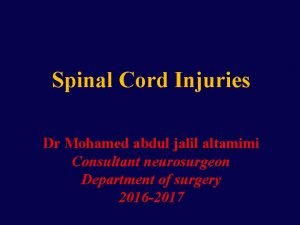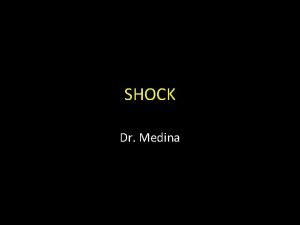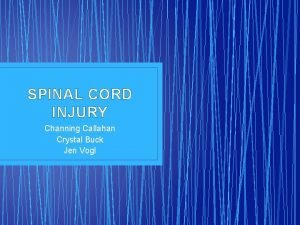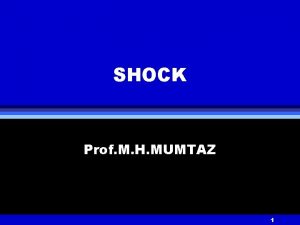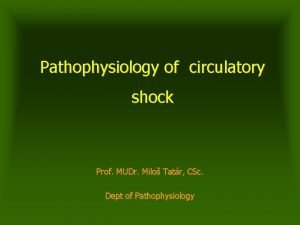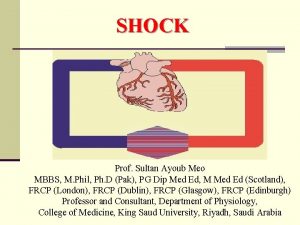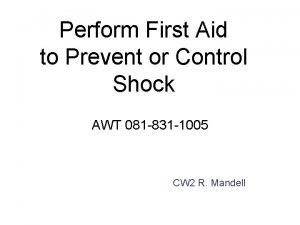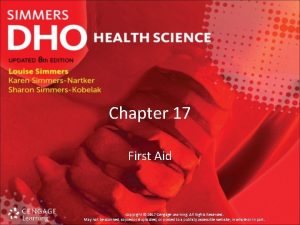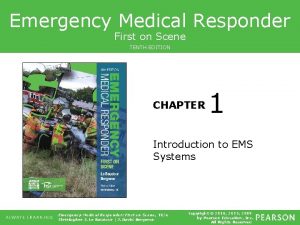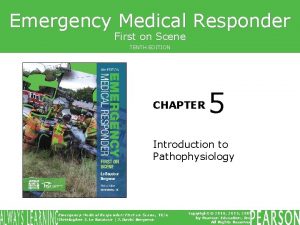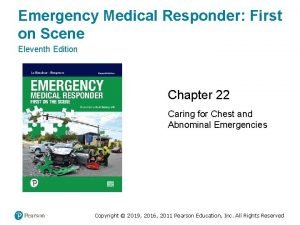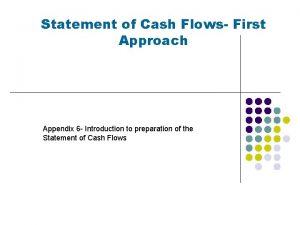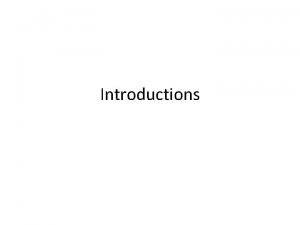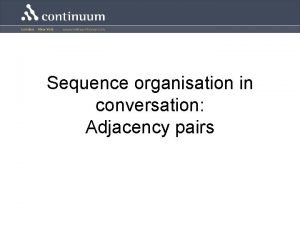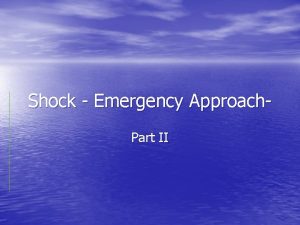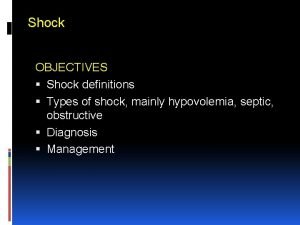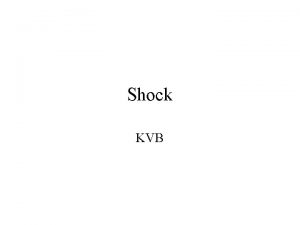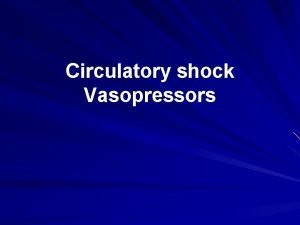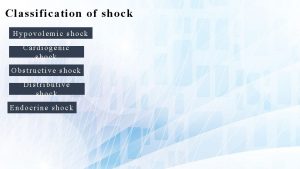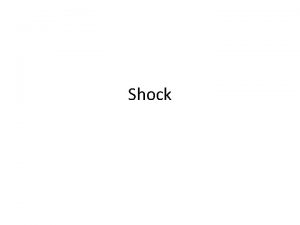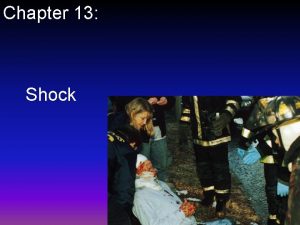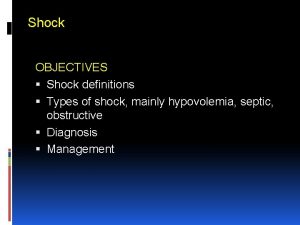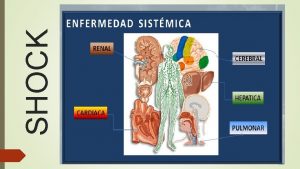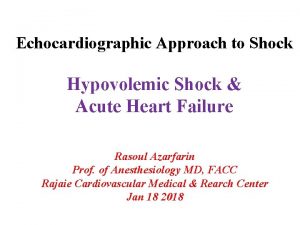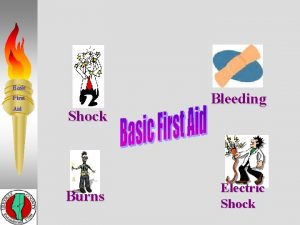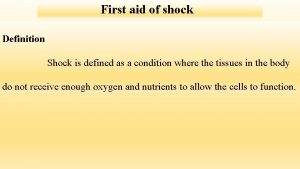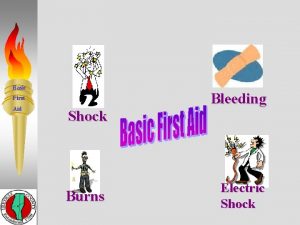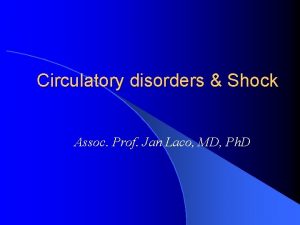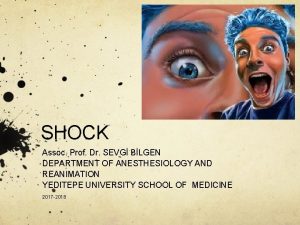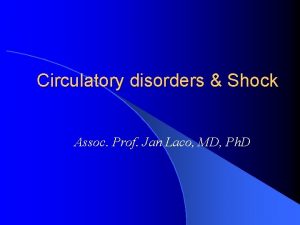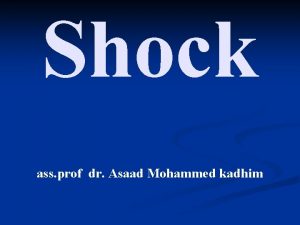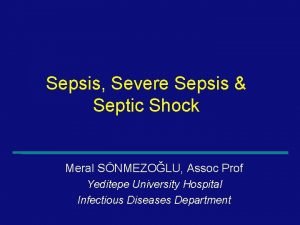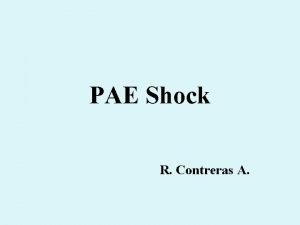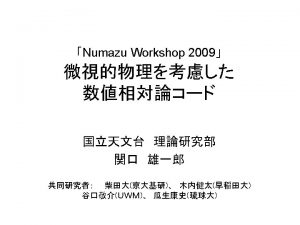Shock Emergency Approach First Part Assoc Prof Dr










































- Slides: 42

Shock - Emergency Approach First Part Assoc. Prof. Dr. Diana Cimpoesu

Shock - definition, epidemiology �Cardiovascular insufficiency that creates an imbalance between tissue oxygen supply and oxygen demand �USA- over 1 milion cases present to the ED/year �Precocious intervention at the non-traumatic patient – “the golden hour”

Shock – classification: 4 categories by etiology �Hypovolemic- due to inadequate circulating volume �Cardiogenic- due to inadequate cardiac pump function �Distributive- maldistribution of blood flowseptic, anaphylactic, neurogenic �Obstructive- extra-cardiac obstruction to blood flow : pulmonary embolism, cardiac tamponade, tension pneumothorax


Shockphysiopathology �Sa. O 2=100%- normal 25% of the transported O 2 linked to Hb is consumed by the tissues – the venous blood will have a saturation of 75% �O 2 supply is insufficient to meet demands- the first compensatory mechanism is the increase of CO (cardiac output) �If the increase of CO is insufficient – the amount of O 2 extracted from Hb by tissues increses and Sm. VO 2 decreases (O 2 saturation of the venous blood)

Shock-physiopathology q Demand>offer – anaerobic metabolism occurs- lactic acid q Lactic Acidosis : due to -the inadequate O 2 delivery ( like in the cardiogenic shock) -Very high demand (consumption of O 2 increased) -Inadequate use of oxygen at the level of tissues (septic shock or post-resuscitation syndrome ) q Lactic acid - marker of the disturbance demand/offer - used in the patient receiving department, diagnosis, treatment, prognosis q MBP=CO x peripheral vascular resistance, q CO decreases- the peripheral vascular resistance increases MBP is not an exact marker of the tissue hypo-perfusion

Shock- physiopathology Compensatory mechanisms: stimulation of carotid baroreceivers – sympathetic NS: �Arteriolar vessel constriction – circulation redistribution �HR increase and miocardial contractilities – increased DC �Constriction on the vessels of potentia �Release of vaso-active hormones (A, NA, D, C)vasoconstriction �ADH release, activation of the renin-angiotensionretension system of Na and water-maintenance of the intravascular volume.

Hemorrhagic shock physiopathology �Compensatory mechanisms: sympathetic hyperactivity to maintain the effective circular volume �Vasoconstriction, circulation centralization, diuresis decrease �Straling forces modification by precapillar sphincter contraction: interstitial hydrostatic pressure increases, cell dehydration – “transcapillar refilling” �O 2 tissular extraction increases (right deviation of Hb. O dissociation curve)


Hemorrhagic shock: decompensation mechanisms �Loss of precapillar sphincter vasoconstriction– vasodilatation, hypotension, myocardium and NCS ischemia, transudation of interstitial liquid �Increase of capillary permeability �Capillary blockage by leukokeratoses micro aggregates �Erythrocytic deformability decrease �Endothelian edema

Shock- physiopathology- cellular effects of O 2 decrease �ATP depletion- membranous pump malfunction. Na inflow and K release �Cellular edema, cells no longer respond to stress hormones (insulin, cortisol, glucagon, catecholamines) �Intracellular destructions- cellular death �Hyper K, hypo Na, metabolic acidosis, hyperglicemia, lactic acidosis

Shock- symptoms �Symptoms suggesting the volume loss: bleeding, vomiting, diarrhea, polyuria, fever �Symptoms suggesting: acute coronary sdr. , congestive acute heart failure, beta-blockers �Anaphylactic context �Neurological disorders: vertigo, lipothymia, alteration of the mental status-coma �Trauma


Shock- physical examination �CV: distension of the throat veins, tachycardia, arrhythmia, decrease of the coronary perfusion pressure, decrease of the ventricle compliance, increase of the diastolic pressure in LV, pulmonary edema �Respiratory: tachypnea, increase of RR, increase of the dead area, bronchospasm, hypocapnia, respiratory failure, acute respiratory distress sdr.

Shock- physical examination �Visceras: ileus, gastrointestinal bleeding, pancreatitis, alithiasic cholecystitis, mesenteric ischemia �Renal: decrease of the glomerulary filtering rate, redistribution of the renal flux, oliguria �Metabolism: respiratory alkalosis, then metabolic acidosis, hypo/hyperglycemia, hyper. K.


Shock –clinical framework �Temperature �Hyperthermia or hypothermia (endogenous=hypo metabolic shock or exogenous). �Cardiac frequency HR �Usually increased; there can also be paroxistic bradycardia in hypovolemic shock, hypoglycemia, beta -blockers, pre-existent cardiac affections. �SBP �In the precocious phase it can be increased because it is a compensatory mechanism and increases DC and then, it decreases. �DBP �Increases at the debut by arterial vessel constriction and then it decreases.

Shock –clinical outview �Pulse pressure �SBP-DBP, depends on the aorta rigidity and on the diastolic volume: it increases precociously in shock and then decreases before SBP. �Paradoxical pulse �The modification of SBP with breath. The increase and decrease of intratoracic pressure affects the cardiac output. �It is met in asthma, cardiac tamponade and decompensate cardiac insufficiency. �MBP = DBP + (MBP – DBP)/3 �Depends on CO şi RP, assures adequate tissular perfusion, decreases in shock.

Shock – Clinical Framework �Shock index = HR/SBP = 0, 5 -0, 7 (n) �Depends on the effort of the LV in acute circulatory insufficiency �CNS: agitation, delirium, confusion, torpor, coma – decrease of pressure of cerebral perfusion �Skin: cold, wet, sweated, cyanosis �CV, respiratory, visceral organs, renal, metabolism – see above

Shock – paraclinic exams �Base evaluation: HLG, electrolytes, glycemia, urea, creatinine, TQ, IQ, a. PTT, urine summary, ecg, thoracic Rx. �Secondary evaluation: arterial blood gases, lactic acid, PDF, hepatic function �Non invasive monitoring: CO 2 -end tidal, DC calculated, echocardiogram �Invasive monitoring: capillary filling pressure, PVC, DC, Sm. VO 2, vascular resistance, DO 2, VO 2 �For etiology and complications: cultures, cranial CT, pelvis, abdominal, lumbar puncter, cortizol level, pelvian and abdominal echography

Shock - treatment �A – IOT, mechanic ventilation, tracheal aspiration �B – decrease of respiratory labor, sedation, mechanic ventilation, decrease of oxygen demand, Sa. O 2 > 93 %, Pa. CO 2 < 35 -40 mm. Hg, p. H > 7, 3 �C – fluid reanimation (crystalline capsule, colloid), peripheral and central venal access, vasopressin for MBP > 60 mm. Hg and SBP > 90 mm. Hg �Decrease O 2 demand – resolving of hyperandrenergic status (analgesic, relaxation, warmth, tranquilizers), Hb > 10 g%

Shock-vasoactive agents �Dopamina: 0 -25 mcg/kg/min, alfa, beta, D �Noradrenaline: 0, 01 -0, 5 mcg/kgc/min, alfa 1, beta 1 �Phenyleffrine: 0, 15 -0, 75 mcg/kgc/min (alfa) �Adrenaline: 0, 01 -0, 75 mcg/kcg/min �Dobutamine: 2 -20 mcg/kgc/min, beta 1, 2, alfa 1 �Isoproterenol: 0, 01 -0, 02 mcg/kgc/min, beta 1, 2

Shock – therapy evaluation parameters �Traditional: BP normalization, HR, urinary output, circulator volume (intra/extra cellular) �CVP 10 -12 mm. Hg, PAOP 12 -18 mm. Hg �MBP 90 -100 mm. Hg, RVP 800 -1400 dynexs/cmp �Contractility: DC 5 l/min, IC 2, 5 -4, 5 l/min/mp �HR 60 -100/min �Tissular oxygenation: Sm. VO 2 > 70 %, acid lactic < 2 mmoli/l

Hypovolemic shock: causes �Hemorrhagic shock �Absolute hypovolemia: diarrhea, vomiting, fever, polyuria, diuretics, burns etc. �Relative hypovolemia: losses in III space – intestinal occlusion, pancreatitis, entero mesenteric attack, edema �Traumatic shock (hemorrhagic shock, spinal shock, obstructive shock)

Hemorrhagic shock: causes �Trauma: lesions of parenchymal organs, lungs, myocardium, big vessels, retroperitoneal hemorrhage, big bones and pelvis fractures, scalp hemorrhages, epitasis �Gastrointestinal: esophageal varices, hemorrhagic ulcer, gastritis, esophagitis, Mallory-Weiss syndrome, tumors, mesenteric ischemia �Genitourinary: vaginal bleeding, neoplasm, abortion, metrorrhagia, placental presentation, placental retention, uterine rupture, ectopic pregnancy �Vascular: aneurisms, aorta dissection, ateriovenous malformation

Hemorrhagic shock: clinic and paraclinic Class II Class. III Class IV < 15 15 -30 30 -40 40 750 800 -1500 -2000 SBP Unmodified Normal Reduced Very low DBP Unmodified Raised Reduced Very low (immeasurable) HR Easy tachycardia 100 -120 (weak) > 120 filiform Blood loss % - Volume ml Capillary refilling Normal Delayed >2 s Undetectable RF Normal Tachipnea > 20/min Urinary output > 30 20 -30 10 -20 0 -10 Extremities Normal colour Pale and cold Conscious state Alert Anxious or aggressive Anxious, aggressive or obnubilated Obnubilated, confused or in a coma

Hemorrhagic shock: Therapeutic objectives �Adequate lung oxygenation �Hemorrhage control �Loss replacements �Monitoring therapy effects �Myocardic contractibility support �Acido-basic and electrolytic reequilibration �Sustaining renal function

Hemorrhagic shock: treatment �ABC �External hemorrhages control: raising the extremities, compressive bandage, surgery �Loss replacement: peripheral and central venous acces, intravascular volume replacement, oxygen transport replacement, coagulation anomalies correction

Crystalline solutions �Isotones: NS, Ringer lactate - replace the interstitial deficit also rapid intra and extra vascular equilibration; it is administrated 3: 1 compared to lost volume of blood �Hypertonic fluids: Na. Cl hypertonic solutionperfusion reduced volume for a satisfactory volemic recovery, positive intropic effect, peripheral vasodilatator; hypernatremia danger, extreme cerebral dehydration (Na >170 m. Eq/l) �Economic reason - accessibility

Colloidal solutions �Important intravascular remanence time, small volumes use for adequate volemic resuscitation, maintenance of intravascular colloidal osmotic, useful in cardiac and renal insufficiency �Albumen, dextran 40 -70, HAES, Haemacel, plasma �High price, anaphylactic reactions, antiplachetary effect and of faking direct compatibility result, histocitary system blockage, infection transmission

Blood transfusion and derivates �O 2 transport capacity increase �Homologous isogroup blood, izo. Rh, integral, eritrocitary mass, washed erytocytes �Artificial blood: perflorocarbonic emulsions, Hb pyridoxilated polymer �Coagulation dysfunction corrections, CID treatment: frozen fresh plasma, heparin therapy �Contribution of citric acid (from preserved blood) and of K, could induce hypocalcaemia ( necessitate 1 g Ca gluconate iv for each 5 U of transfused blood or plasma) �Auto transfusion

Hemorrhagic shock: treatment Class I 2, 5 l Ringer lactate or physiological solution or 1 l colloid Class II 1 l colloid + 1, 5 l Ringer lactate or physiological solution Class III 1 l Ringer or Na. Cl + 0, 5 l colloid + 1 -1, 5 l integral blood or an equivalent volume of erythrocytic mass Class IV 1 l Ringer or Na. Cl + 1 l colloid + 2 l integral blood or an equivalent volume of erythrocytic mass and colloid

Therapy efficiency �Blood pressure MBP 90 -100 mm. Hg �HR, RR �Urinary output �CVP 10 -12 mm. Hg �Consciousness state �Skin coloring, capillary refil time<2 sec �Paraclinic parameters : CO 2, p. H gastric mucous membrane, IC, Sm. VO 2, lactic acid < 2 mm/l

Anaphylactic shock �Anaphylaxis – a systemic, severe reaction of hypersensitivity accompanied by low blood pressure and by compromising the airways with vital risk, determined by anaphylaxis mediators release (Ig. E from mast cells) �Anaphylactic syndrome- the same reaction without Ig. E �Incidence: in the USA varies between 5/1000 and 2/10000

Anaphylactic shock-physiopathology �Hypersensitivity reaction type I-Ig. E �Mast cells digranulation �Mediators issue �Complement activation �Metabolism modulation arachidonic acid �But also hypersensitivity reaction of type II and III

mast cells and basophile degranulation Ag Ig. E mast cells and basophile Release of mediators from mast cells and basophiles in an Ig. E dependent fashion: bradikinine, histamin, serotonin. Complement Activation Modularea metab. ac. arahidonic, Leucotriene, PG, Tx:

Anaphylactic shock: causes � Medicines � Penicillin and other � aspirin � trimetroprim � AINS � Foods and additives � Sea fruits, fish � Soy, nuts � Flour, milk, eggs � Monosodium glutamate, tartrasine � Nitrates and nitrites � Others � Hymenoptera stings � Insects � Contrast substances from radiology

Anaphylactic shock-clinic �Urticaria �Angioedema �Non systematic abdominal pains �Nausea, vomiting, diarrhea �Bronchospasm �Rhinorrhea �Conjunctivitis �Lipothymia or palpitations �Anaphylaxis= any combinations of these signs and low blood pressure or compromising of air way

Clinic signs evolution �Pruritus �Erythema �Urticaria �Dyspnea, anxiety, lipothymia, syncope �Apparition within 60 minutes from the exposuregravity sign – death risk �Symptoms recurrence - biphasic phenomenon - 20% of patients

Positive and differential diagnosis Positive = historic and physical exam Differential: �Vague vessel reactions �Myocardium ischemia �Status astmaticus �Convulsions �Epiglottises �Congenital angioedema �Obstruction of air ways by foreign bodies �Laboratory: histamine, high tryptase

Treatament �A- angioedema, air ways release �B- IOT or oxygen therapy �C- i. v. access, monitorising, pulse oxymetry �Adrenaline- treats the bronchospasm, laryngeal edema, laringospasm, respiratory stop, shock: i. v. bolus 100 mcg (1: 100000) �Perfusion 1 -4 mcg/min �I. m- 0, 5 mg �S. c- 0, 3 -0, 5 ml of 1: 1000

Treatament �Fluids i. v. 1 -2 l or 20 ml/kg �Corticosteroids: methylprednisolon 125 mg i. v. �Blockings H 1 - diphenhydramine 25 -50 mg i. v. , i. m. , p. o. �Blockings H 2 - ranitidine 50 mg i. v. �Nebulised albuterol 2, 5 mg or 5 mg/kg i. v. �Glucagon 1 mg i. v. la 5 min. then 5 -15 mcg/min �Aminophyline 5 -6 mg/kg i. v.
 Common lisp sort
Common lisp sort Angus gestation calculator
Angus gestation calculator Site:slidetodoc.com
Site:slidetodoc.com Diferencia entre shock medular y shock neurogenico
Diferencia entre shock medular y shock neurogenico Spinal shock vs neurogenic shock
Spinal shock vs neurogenic shock Spinal shock vs neurogenic shock
Spinal shock vs neurogenic shock Spinal shock vs neurogenic shock
Spinal shock vs neurogenic shock Shock prof
Shock prof Shock prof
Shock prof M
M Entity framework 7 release date
Entity framework 7 release date Unit 15:6 providing first aid for burns
Unit 15:6 providing first aid for burns Chapter 17:1 providing first aid
Chapter 17:1 providing first aid Pervent
Pervent 17:8 providing first aid for cold exposure
17:8 providing first aid for cold exposure Pa wc bureau
Pa wc bureau Chapter 8 emergency care first aid and disasters
Chapter 8 emergency care first aid and disasters Emergency medical responder 10th edition
Emergency medical responder 10th edition Emergency medical responder first on scene 10th edition
Emergency medical responder first on scene 10th edition Emergency medical responder first on scene 11th edition
Emergency medical responder first on scene 11th edition Difference between virtual circuit and datagram
Difference between virtual circuit and datagram Cognitive approach vs behavioral approach
Cognitive approach vs behavioral approach Waterfall strategy marketing
Waterfall strategy marketing Multiple approach avoidance
Multiple approach avoidance Bandura's reciprocal determinism
Bandura's reciprocal determinism Research approach means
Research approach means Diagram for traditional approach
Diagram for traditional approach Tony wagner's seven survival skills
Tony wagner's seven survival skills Part whole model subtraction
Part whole model subtraction Unit ratio definition
Unit ratio definition Part part whole
Part part whole Technical description
Technical description What are the parts of a bar
What are the parts of a bar The phase of the moon you see depends on ______.
The phase of the moon you see depends on ______. Two way anova minitab 17
Two way anova minitab 17 Assumptions of psychodynamic theory
Assumptions of psychodynamic theory Customer first approach
Customer first approach Criticism
Criticism Coverdale's 'systematic approach to getting things done
Coverdale's 'systematic approach to getting things done Cash flow adjustments
Cash flow adjustments First part of introduction
First part of introduction Part one to kill a mockingbird summary
Part one to kill a mockingbird summary List of adjacency pairs
List of adjacency pairs


